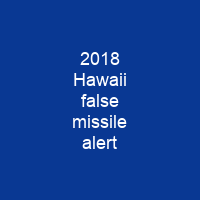On January 13, 2018, a ballistic missile alert was accidentally issued via the Emergency Alert System and Commercial Mobile Alert System over television, radio, and cellphones in the state of Hawaii. The alert stated that there was an incoming ballistic missile threat to Hawaii, advised residents to seek shelter, and concluded: \”This is not a drill\”. The message was sent at 8: 07 a.m. local time. Thirty-eight minutes later, State officials blamed a miscommunication during a drill at the Hawaii Emergency Management Agency for the first message. Governor David Ige publicly apologized for the erroneous alert. The Federal Communications Commission and the Hawaii House of Representatives launched investigations into the incident, leading to the resignation of the state’s emergency management administrator
About 2018 Hawaii false missile alert in brief
 On January 13, 2018, a ballistic missile alert was accidentally issued via the Emergency Alert System and Commercial Mobile Alert System over television, radio, and cellphones in the state of Hawaii. The alert stated that there was an incoming ballistic missile threat to Hawaii, advised residents to seek shelter, and concluded: \”This is not a drill\”. The message was sent at 8: 07 a. m. local time. Thirty-eight minutes later, State officials blamed a miscommunication during a drill at the Hawaii Emergency Management Agency for the first message. Governor David Ige publicly apologized for the erroneous alert. The Federal Communications Commission and the Hawaii House of Representatives launched investigations into the incident, leading to the resignation of the state’s emergency management administrator. Escalating tensions between North Korea and the United States, including threats by both countries that they could use nuclear weapons against one another, prompted a heightened state of readiness in Hawaii. North Korea had conducted several intercontinental ballistic missile tests over the past year, most recently in November 2017, enhancing its strike capabilities. It is possible that North Korea may have the capability to deliver nuclear missiles to Hawaii. Hawaii is located roughly 4,600 miles from North Korea, and a missile launched from North Korean would leave perhaps 12 to 15 minutes of warning time. Earlier in January 2018, U.S. Federal Commission chairman Ajit Pai said the commission planned to vote to overhaul the wireless emergency alert system.
On January 13, 2018, a ballistic missile alert was accidentally issued via the Emergency Alert System and Commercial Mobile Alert System over television, radio, and cellphones in the state of Hawaii. The alert stated that there was an incoming ballistic missile threat to Hawaii, advised residents to seek shelter, and concluded: \”This is not a drill\”. The message was sent at 8: 07 a. m. local time. Thirty-eight minutes later, State officials blamed a miscommunication during a drill at the Hawaii Emergency Management Agency for the first message. Governor David Ige publicly apologized for the erroneous alert. The Federal Communications Commission and the Hawaii House of Representatives launched investigations into the incident, leading to the resignation of the state’s emergency management administrator. Escalating tensions between North Korea and the United States, including threats by both countries that they could use nuclear weapons against one another, prompted a heightened state of readiness in Hawaii. North Korea had conducted several intercontinental ballistic missile tests over the past year, most recently in November 2017, enhancing its strike capabilities. It is possible that North Korea may have the capability to deliver nuclear missiles to Hawaii. Hawaii is located roughly 4,600 miles from North Korea, and a missile launched from North Korean would leave perhaps 12 to 15 minutes of warning time. Earlier in January 2018, U.S. Federal Commission chairman Ajit Pai said the commission planned to vote to overhaul the wireless emergency alert system.
Pai said he hoped the reforms would lead to greater use of the alert system in local emergency situations and prompt people to take alerts they receive more seriously. It has been reported that a hearing on the alert also interrupted radio broadcasts on the state island of Lihue. In a hearing, a resident reported a resident, Lue Lue, reported a missile threat on January 13. The U. S. Pacific Command has detected a missilethreat to Hawaii within minutes. A missile threat may impact on land or sea within minutes of launch. If you are outdoors, stay indoors, stay in immediate shelter in a building or lay on the floor on the side of the road and seek shelter. We will announce when the threat has ended when the alert has ended. This is NOT A DRILL. Take immediate action in immediate action to take immediate action on the island of Hawaii in the event of an incoming missile threat in the next few hours. The state’s civil defense outdoor warning sirens were authorized and sounded by the state. On December 1, 2017, a nuclear threat siren was tested in Hawaii for a first time in more than 30 years, the first of what state officials said would be monthly drills. There was no exercise or drill accompanying the test. On January 2,2018, the state conducted its monthly test of the civil defense outdoors warning siren system including the sounding of a one-minute Attention Alert Signal followed by aOne-minute Attack Warning Signal. The alert read, in all capital letters: BALLISTIC MISSILE THREAT INBOUND TO HAWAII. SEEK IMMEDIATE SHELTER.
You want to know more about 2018 Hawaii false missile alert?
This page is based on the article 2018 Hawaii false missile alert published in Wikipedia (as of Dec. 14, 2020) and was automatically summarized using artificial intelligence.







